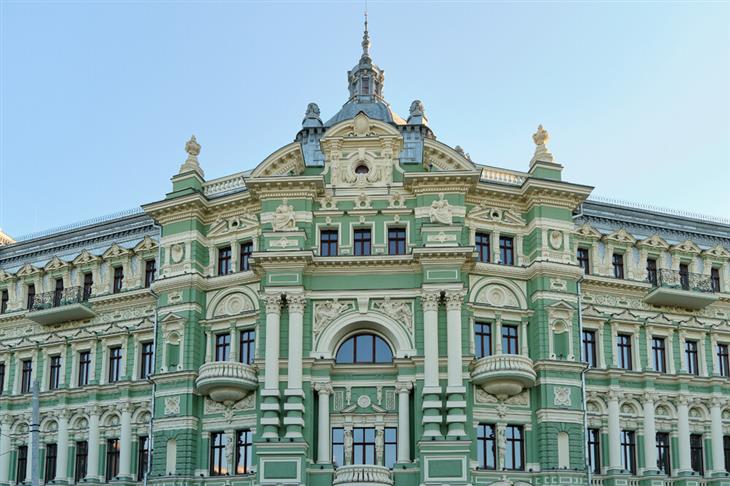1. The medieval Jewish heritage in Erfurt, Germany
At the heart of Erfurt, there stands a collection of impeccably preserved edifices associated with the Jewish communities that have resided there since medieval times. This ensemble includes an ancient synagogue, mikveh, and residential structures. What sets them apart is their ability to depict the way in which Jewish communities lived and adjusted to life in a predominantly Christian city during the Middle Ages. Additionally, they offer insights into the history of Jewish commerce in Central Europe from the 11th to the 14th centuries until it was disrupted by the Black Death plague. These structures hold significance as they rank among some of the oldest instances of Jewish architectural heritage in Central Europe, as they seamlessly blend with local architectural styles.
2. The historical district of Kuldīga in Latvia
Kuldīga's ancient town is famed for its impeccably maintained structures and its Baltic architectural heritage, tracing its origins to the 13th century. It boasts a storied history as a hub of commerce, with its buildings reflecting influences from diverse styles resulting from the integration of indigenous inhabitants with foreign artisans. Despite facing numerous threats from fires and floods throughout history, stringent construction protocols and regulations have predominantly safeguarded the old city's character.
3. Archaeological Site of Koh Ker, Cambodia
Koh Ker served as the primary city of the Khmer Empire from 921 to 944 and is situated within a dense forest nestled between two mountain ranges in Cambodia. King Jayavarman IV established this city, celebrated for its distinctive temples and sculptures. Despite its brief tenure as a capital, its one-of-a-kind architectural style and construction methods significantly influenced the region's art and architecture, particularly evident in the Kuh Ker style sculptures that continue to fetch high prices at auctions today.
The site boasts a fusion of Indian and local artistic influences, along with an avant-garde approach to construction using large stones. Remarkably unchanged since abandonment in the 15th century, it holds immense historical significance warranting preservation, hence earning recognition as a World Heritage Site
4. Ancient Sites of Talayotic Menorca, Spain:
Situated on the Spanish island of Menorca, this array of sites spans from the Bronze Age to the Late Iron Age. It boasts a remarkable assortment of cyclopean architecture, characterized by the utilization of large stones in constructing various edifices such as hypogeums (subterranean burial sites), tliots (a form of megaliths), hypostyles (chambers with ceilings supported by columns), and circular-shaped dwellings - all built without the use of cement. The arrangement and layout of these structures offer insights into the progression of social hierarchy, interpersonal connections, and cosmological convictions.
5. Sacred Hoysala Complexes in South India
The Hoysala Empire constructed a trilogy of Hoysala-style temples in South India during the 12th and 13th centuries, known as the sacred Hoysala complexes. These architectural marvels were crafted to distinguish themselves from contemporary kingdoms and dynasties, showcasing an exceptional architectural style developed by the early Husila rulers for their sacred structures. Their distinctive design, coupled with remarkably lifelike sculptures and stone carvings, led to their inclusion in the prestigious UNESCO World Heritage Sites list.
6. Si Thep in Thailand
Si Tep town and its associated structures have origins ranging from the 6th to the 10th centuries, displaying the cultural and religious evolution in Southeast Asia under the sway of Indian customs. These structures are spread across multiple locations and collectively showcase a variety of architectural designs, artistic expressions, and faiths that mirror Hinduism, Theravada Buddhism, and Mahayana Buddhism. Notably, Si Tep is renowned for its distinctive art featuring sculptures positioned in tribhanga (standing with a slight pelvic inclination), which significantly influenced later Southeast Asian cultural artistry.
7. La Maison Carrée in Nîmes, France
The place's name, "the square house of Nimes," is a direct translation, and it stands as an ancient Roman temple constructed in 16 BC. Impressively preserved to this day, it serves as a testament to the authority and ideology of the Roman Empire. Initially dedicated to the gods, an inscription on the temple reveals its dedication to Agrippa's adopted sons - Gaius and Lukius - by Augustus after his demise. Over time, this temple transitioned into various roles including a church, private residence, stable, and town hall before transforming into a museum in 1823.
8. Odessa's Old Town, Ukraine
The significance of Odessa's old town lies in its status as a bustling port city that embraces diverse cultural influences. Its inception dates back to 1794, following the conclusion of the Ottoman-Russian war, and burgeoned rapidly throughout the 19th century propelled by the prosperity of its port and governance strategies. The urban landscape of Odessa is an intricate web of thoroughfares adorned with edifices representing a myriad of architectural designs, serving as testaments to the city's opulent and extensive past. Notable landmarks within the historical district include the renowned Potemkin Steps and the illustrious Odessa Opera House.

Photo sources:
Werner Streitberger,
Larissa Sabottka,
Archive of Kuldīga Municipality,
Krists Spruksts, National Authority for Preah Vihear (NAPV) (
1)(
2),
Mario Gutiérrez,
Juan Antonio Belmonte,
Ar Maniyarasan R,
Aravind C, (
1)(
2) The Fine Arts Department,
Dominique Marck Dominique Marck,
Ville de Nîmes, (
1)(
2) Alexey Acepovsky, Yuri Filonenko, Dmitry Moiseev,
